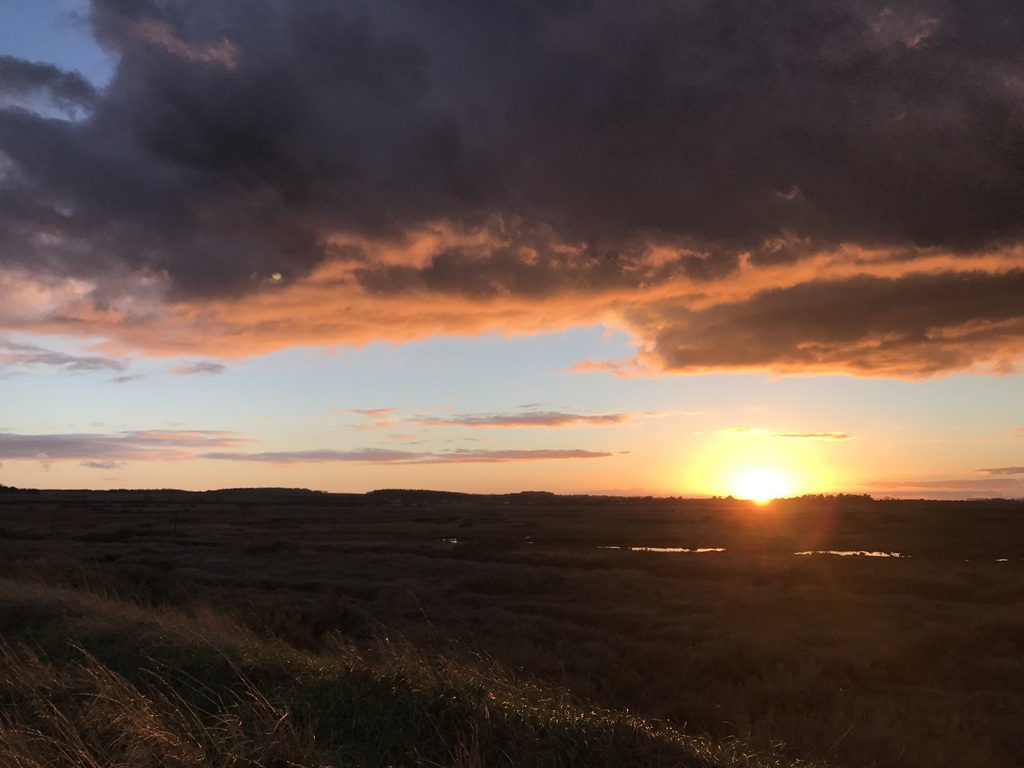Day 3 of a three day long weekend of tours today, our last day. It was forecast to rain for much if not all of the day today. Fortunately, we had a rather drier start to the day and, even though it did rain for a few hours through the middle of the day, it dried out again for much of the afternoon. And the wind had thankfully dropped compared to yesterday. We spent the day up on the North Norfolk coast.
As we drove up towards the coast, we could see a large flock of Pink-footed Geese flying over, coming in from the roost and heading for a recently harvested sugar beet field, where they would spend the day feeding. We drove round to the field and watched them dropping down to join the few geese which were already there. There have been some other geese in with the Pink-footed Geese in recent days and we were keen to try to see them, so we set about scanning through the flock.
It didn’t take long to find the Barnacle Geese. With their pale grey and white bodies, black necks and white faces, they really stood out. We have an increasing number of feral Barnacle Geese turning up here and it is difficult to tell which are really wild these days, but birds which turn up with the Pink-footed Geese are perhaps more likely to have come from one of the Arctic island populations.

More Pink-footed Geese were arriving all the time. We could hear them calling away to the west as they approached, long before we could see them, and we watched as they circled down and landed in the field. We were looking for a couple of Tundra Bean Geese which have been with the geese here but despite scanning through several times we couldn’t find them. We weren’t sure whether they hadn’t arrived yet, or whether they had landed just over a low ridge in the middle of the field, out of view.
We did spot a male Bullfinch feeding in the brambles in the hedge behind the geese, which we could make out through the scope. Several Brown Hares were in the surrounding fields too.
There was still no sign of any Tundra Bean Geese from this end of the field, but we received a message to say one was on view at the other end. We drove a short distance further along the road and joined a couple of people who were scanning the flock from the hillside there. From here, we could see the geese on the other side of the ridge in the middle of the field. There, on the front edge of flock, was a goose with bright day-glo orange legs and bill band – a Tundra Bean Goose.
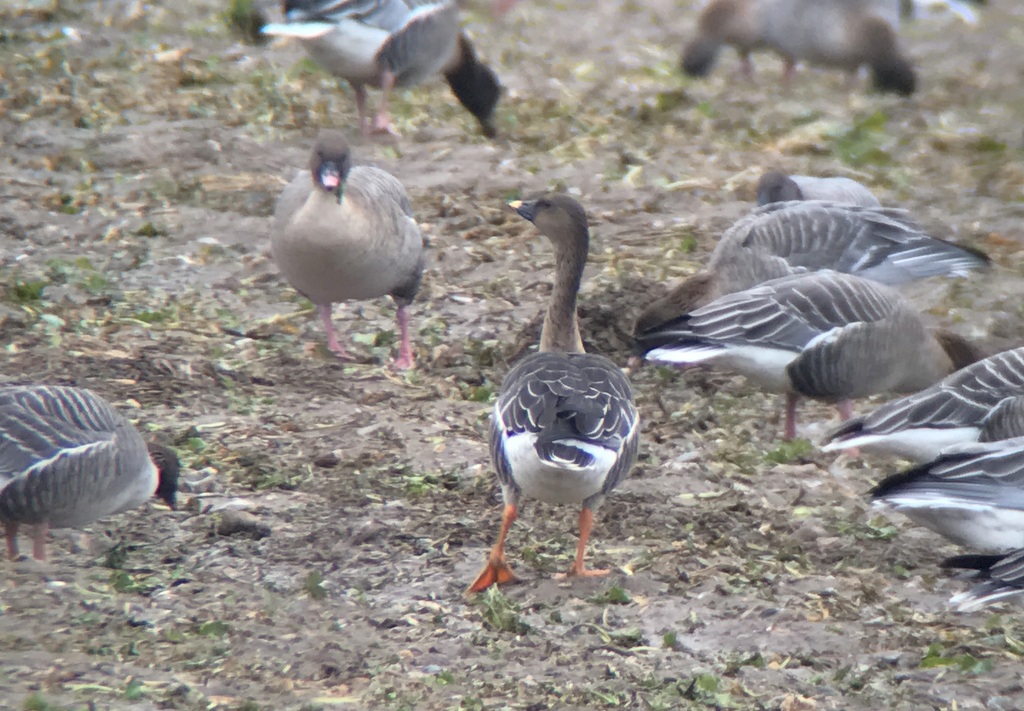
After a good look at the Tundra Bean Goose through the scope, with our mission here accomplished, we dropped down to the coast at Cley and parked at the beach. As we walked out along the shingle, we scanned the sea. A Great Crested Grebe and a Guillemot were diving just offshore and further out, we could see small numbers of Red-throated Divers, flying past or swimming on the calm water.
Crossing the grassy ridge, we flushed a number of Skylarks and Meadow Pipits from the weedy vegetation on the edge of the shingle. A flock of mainly Ringed Plover and a few Dunlin flew over calling. We could see several Pintail feeding on North Scrape.
From the other side of the ridge, we could see the juvenile Glaucous Gull down on the shingle. It has been here for over a month now, feeding on the carcasses of seals washed up in the winter storms, and was busy attacking its current favourite. We walked over for a closer look – as a young gull from the arctic, it has possibly not seen people before arriving here and is very approachable.
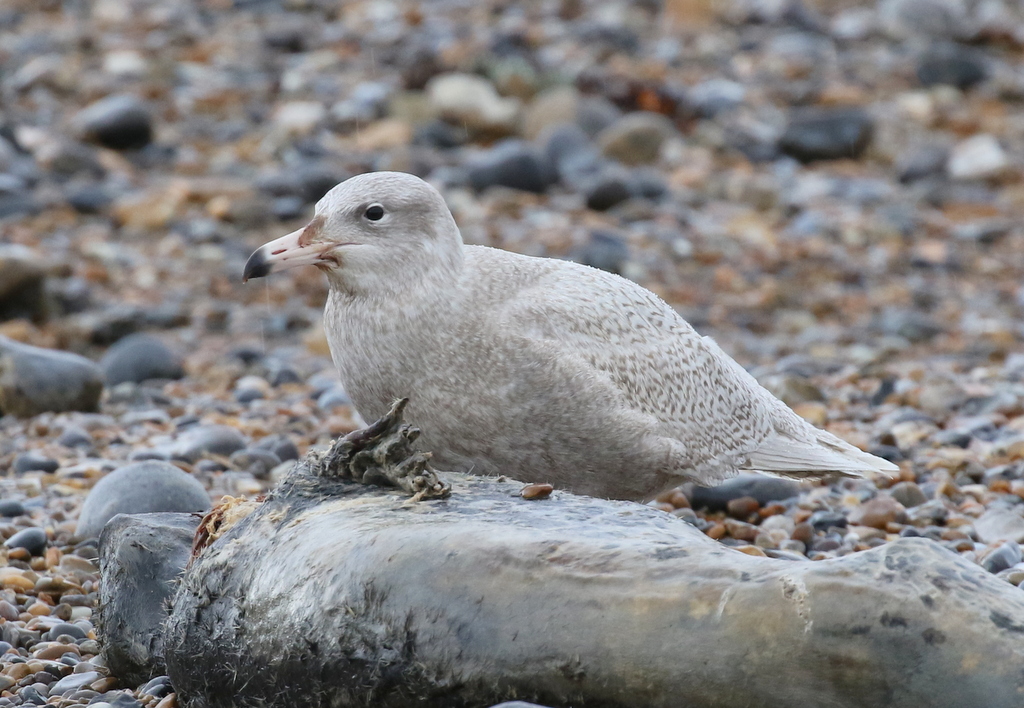
The Glaucous Gull was very pale, biscuit coloured, on closer inspection patterned with pale grey-brown on the back, much paler and lacking the darker spotting of a nearby young Great Black-backed Gull. We could also see the Glaucous Gull‘s distinctive pale wingtips and its large pink bill with a contrasting dipped-in-ink black tip.
There were dark clouds approaching from the west, and it started to spit with rain, so we turned and walked back. We had been lucky that it had been mostly dry so far this morning. As we drove west along the coast road, we drove into heavier rain. We had a quick look at Wells but there was no sign of any Brent Geese on the fields along Beach Road, so we headed on round to Holkham.
As we got out of the van at Lady Anne’s Drive, we could see lots of Greylags and a few Pink-footed Geese out on the grazing meadows. Groups of Wigeon were scattered liberally over the grass. There were several waders round the pools – mostly Redshank, and Lapwing, plus a few Curlew, a small group of Black-tailed Godwits and one or two Ruff. There were lots of Pied Wagtails feeding in the wet grass too.
With the rain falling steadily now, we stopped for a quick coffee break in ‘The Lookout’ café. There was no sign of it clearing, but it didn’t seem to be coming too hard, so we decided to make a bid for the beach. It had been quite calm on the beach at Cley just an hour back, but when we got to the other side of the pines, we found that the wind had picked up and was driving the rain across the saltmarsh.
There was a lot of standing water on the saltmarsh, which appeared to appeal to the Rock Pipits, as we found at least four feeding around the pools when we stopped to scan. As we got to the cordon, we could see the Snow Buntings feeding down on the sand at the far end, flying up and whirling round occasionally. We walked down for a closer look and the flock flew round and landed right in front of us.

With the saltmarsh so wet today, there was no sign of any Shorelarks. Despite having a thorough search of their favourite areas, we couldn’t find them today. We figured they might be out at the beach, but with everyone cold and wet now, we reluctantly decided to head back.
A flock of Brent Geese was feeding out on the saltmarsh as we turned to head back. Looking more closely, we could see that one was noticeably darker than the others, with a more striking pale flank patch and collar. It was the regular Black Brant hybrid which is often found here.

As we made our way back through the pines, two Goldcrests were feeding in the low bushes by the path. We decided to make use of ‘The Lookout’ for lunch, and to try to dry out a bit. A pair of Stonechats were flying around the small bushes out on the grazing marshes.
Finally, the sky looked to be brightening out to the west, so we decided to drive towards it. Before we left Holkham though, a quick scan of the grazing marshes produced a Great White Egret. Big and white, it really stood out, particularly when it flew across.
We took a detour round via Choseley. There was no sign of the reported Rough-legged Buzzard around the drying barns, but we could see several Common Buzzards perched on various hedges. A flock of Yellowhammers was feeding in the weedy edge of a sugar beet field, and with the rain now stopped a flock of Skylarks was flying round over a grassy meadow.
Dropping down to Thornham Harbour, the marshes here all looked rather quiet at first. Down in the harbour channel, a Little Egret was running up and down in the shallow water and a Curlew, a Common Redshank and a lone Black-tailed Godwit were feeding on the muddy bank. There was no sign of any Twite here.
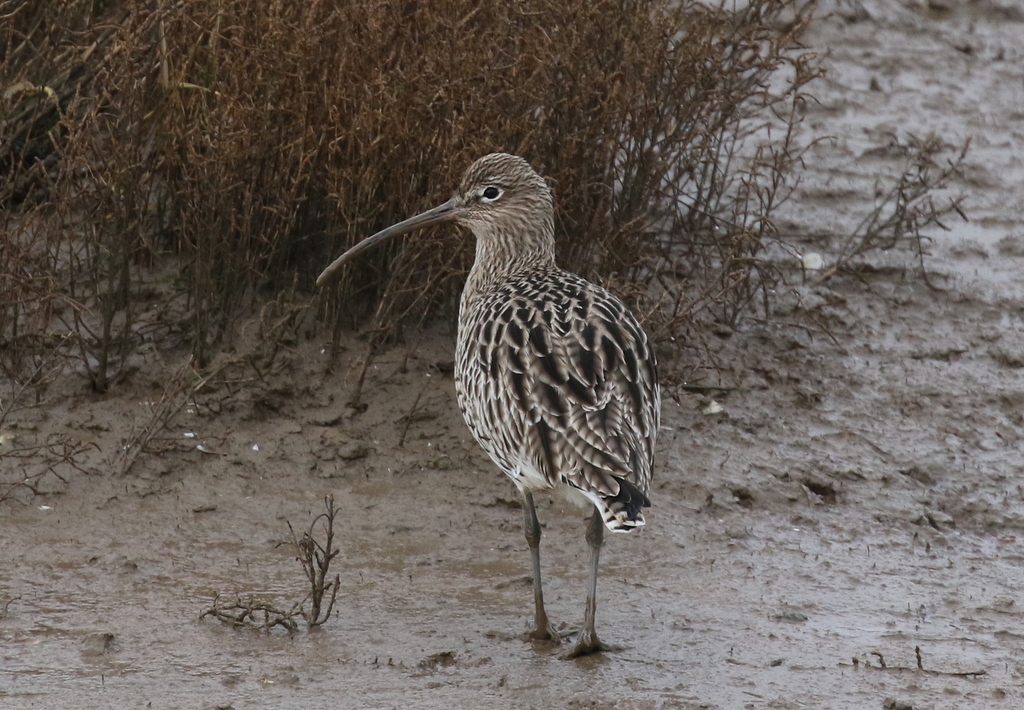
We decided to try our luck out along the seawall. There were more waders further out in the harbour. A Spotted Redshank was preening on the edge of the water and a Greenshank was further out on the top of the muddy island. Several Grey Plovers were feeding on the mud.
It was rather fresh up on the seawall, still chilly in the breeze. Scanning from the corner, we spotted the Twite, much further along towards Holme, as they flew up briefly and landed back down on the edge of the saltmarsh. We set off to walk along for a closer look, but before we could get there the Twite flew up again. They came straight towards us, and landed on the barbed wire fence just below the bank. We had a great view of them through scope – we could see their rusty-orange breasts and yellow bills.
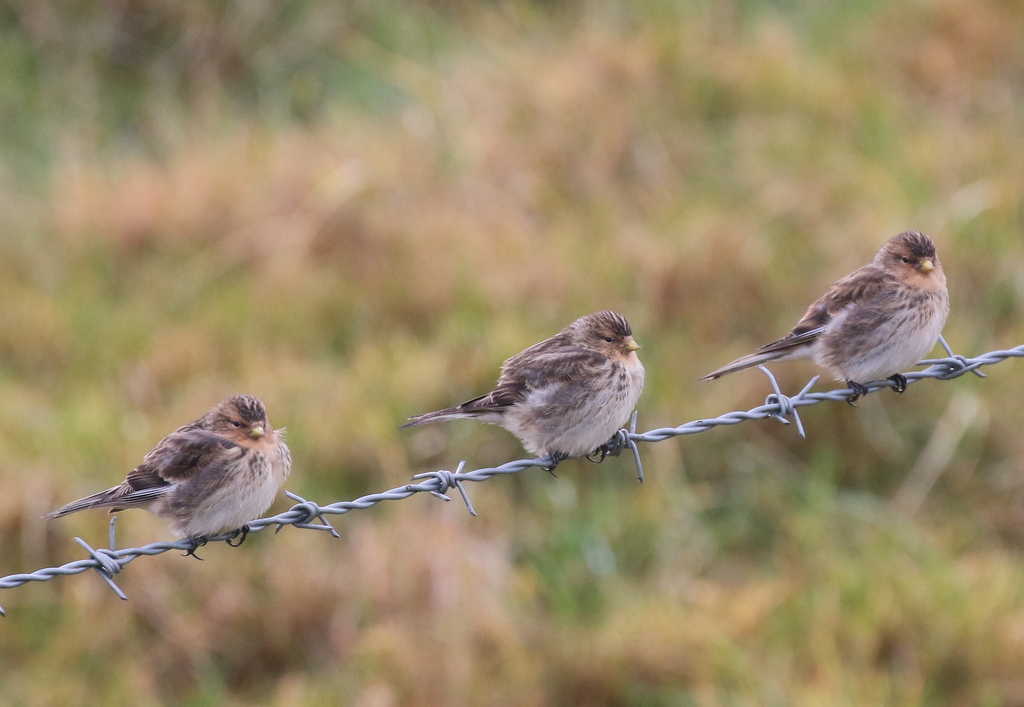
There were some dog walkers coming the other way along the bank towards us and when the dogs ran along the bank past the Twite they took off again. They came straight over us, and headed back towards the Thornham Harbour. We walked back and found them feeding on the edge of the saltmarsh with a couple of Linnets.
We headed round to Titchwell to finish the afternoon. After having a look in the sightings book in the visitor centre, we were just leaving by the far door when we spotted a Barn Owl hunting over the Thornham grazing marsh beyond the trees. We hurried out to the main path and we were just watching the first Barn Owl hunting when we saw a second one fly across in front of us.
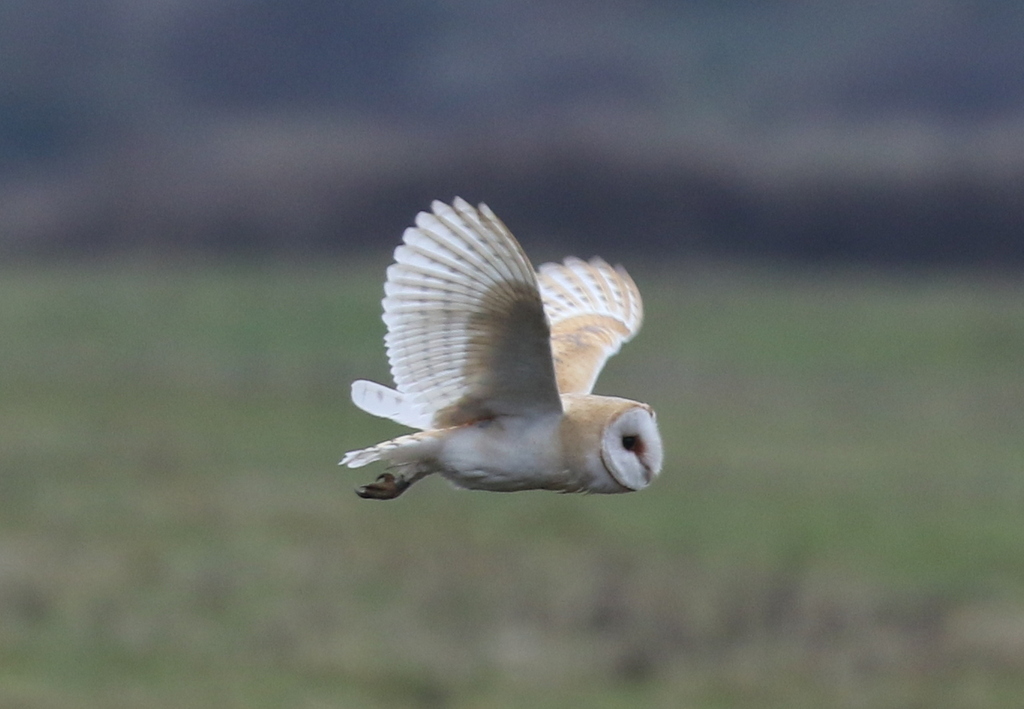
When the Barn Owls finally disappeared out of view behind the trees, we turned our attention to the ditches below the path. After a quick walk up to the corner and back scanning, we found a Water Rail feeding quietly in the muddy water in the bottom, probing in the wet the leaves. This is a great place to get really good views of this normally secretive species.
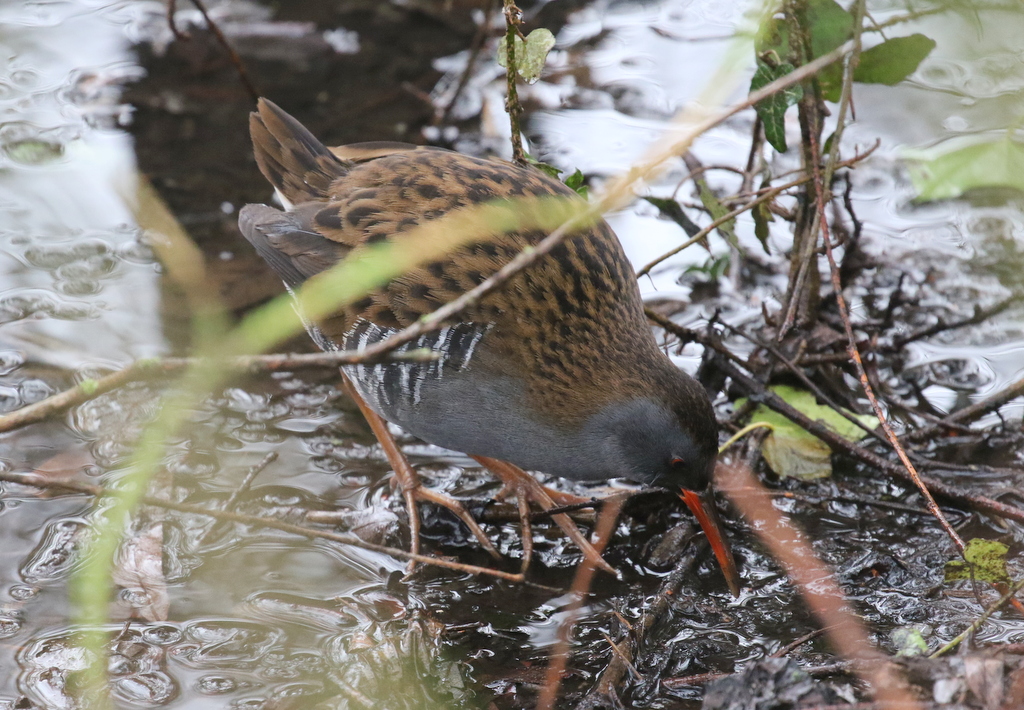
Round along Fen Trail, there was no sign of any Woodcock this afternoon, so we continued on to Patsy’ Reedbed. Three Marsh Harriers were circling over the reedbed in front, dropping down into the reeds then coming back up, occasionally swooping at each other and talon grappling at one point. There were more Marsh Harriers further back, over the bank on the Brancaster side, and we counted at least 15 in the air together at one point.
There were a few ducks out on the water, mainly Common Pochard and a pair of Gadwall. Several Teal were loafing in the cut reeds at the front and scanning carefully we found several Common Snipe asleep in there too.
We made our way back round to the main path via Meadow Trail. As we walked out towards the Freshmarsh, a Water Pipit flew up from the dried up pool on Thornham grazing marsh calling. It flew overhead, across the path and out across the reedbed. A Cetti’s Warbler called from somewhere down in the reeds.
The Freshmarsh is still very full of water, particularly so after the rain, and there was very little exposed island left. There were a few ducks scattered around, mainly Wigeon and Teal, and a flock of Lapwings on the bits of the fenced off Avocet Island which were still above water. A Barn Owl was hunting along the bank by Parrinder Hide, and then crossed over the main path and headed out over the saltmarsh.
We decided to continue on out to the beach. There were a few more waders on Volunteer Marsh. A Ringed Plover was down on the mud and we watched a Grey Plover wrestle with a long worm, finally pulling it out of its hole. There were more Curlews and Redshanks along the channel at the far side, and a closer Black-tailed Godwit.
The no longer tidal ‘Tidal Pools’ are very full of water at the moment too, with very few places for the waders to roost now. The three Avocets which are still clinging on here for the winter were looking rather lost, roosting up to their bellies in the water.
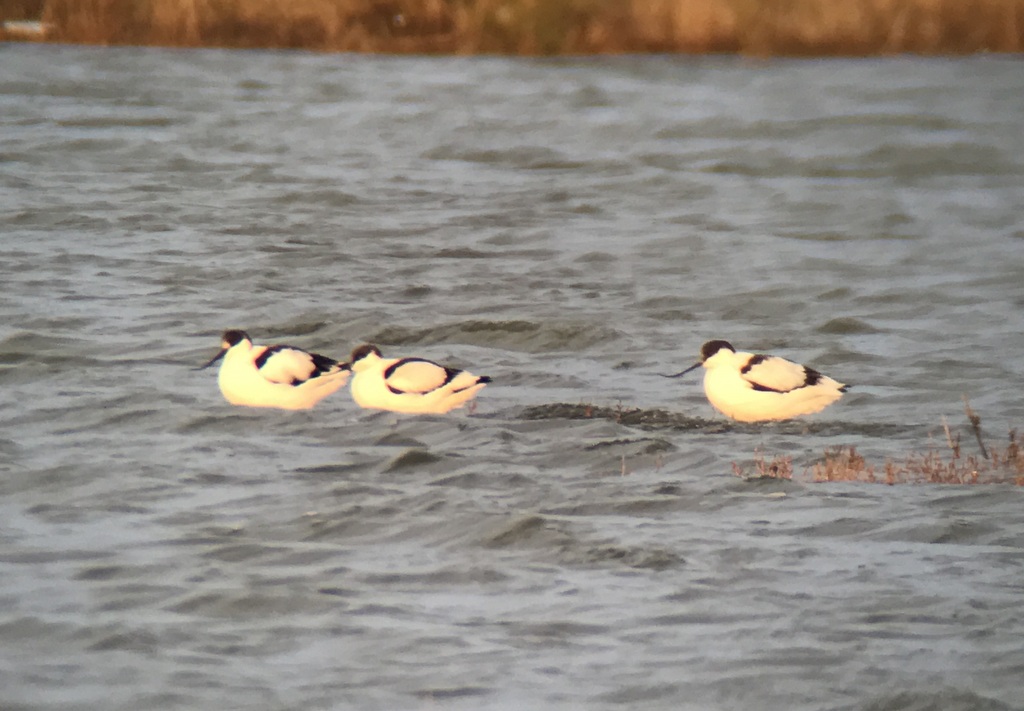
Out at the beach, there were lots of waders on the mussel beds when we arrived, but something spooked them and they all flew round and landed on the beach. There were lots of Knot, Dunlin and Bar-tailed Godwits, several more Grey Plovers and one or two Turnstones. A few Sanderling were running in and out ahead of the waves breaking along the shoreline. There was not much out on the sea this afternoon. We managed to find just a single distant Goldeneye and two Great Crested Grebes.
It was time to head back now. The weather had finally improved, a bit late in the day, and we were treated to a glorious sunset away to the west as we walked back along the main path.
